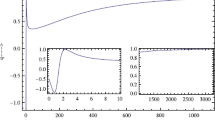Abstract
We covariantly modify the Einstein–Hilbert action such that the modified action perturbatively resolves the anomalous rotational velocity curve of the spiral galaxies and gives rise to the Tully–Fisher relation, and dynamically generates the cosmological constant. This modification requires introducing a single new universal parameter. It requires inclusion of neither dark matter nor dark energy.
Similar content being viewed by others
References
Sobouti, Y., Hasani Zonoozi, A., Haghi, H.: Tully–Fisher relation, key to dark matter companion of baryonic matter. Astron. Astrophys. 507, 635 (2009). arXiv:0906.0668 [gr-qc]
Sobouti, Y.: Dark companion of baryonic matter—logarithmic potentials are inherent to GR. arXiv:0812.4127 [gr-qc]
Sobouti, Y.: Dark companion of baryonic matter. arXiv:0810.2198 [gr-qc]
Rubin, V., Thonnard, N., Ford, W.K.: Rotational properties of 21 Sc galaxies with a large range of luminosities and radii from NGC 4605 (R=4kpc) to UGC 2885 (R=122kpc). Astrophys. J. 238 (1980). doi:P10.1086/158003
Persic M., Salucci P., Stel F.: The Universal rotation curve of spiral galaxies: 1. The dark matter connection. Mon. Not. Roy. Astron. Soc. 281, 27 (1996) arXiv:astro-ph/9506004
Borriello A., Salucci P.: The dark matter distribution in disk galaxies. Mon. Not. Roy. Astron. Soc. 323, 285 (2001) arXiv:astro-ph/0001082
Salucci P., Lapi A., Tonini C., Gentile G., Yegorova I., Klein U.: The universal rotation curve of spiral galaxies. II: The dark matter distribution out to the virial radius. Mon. Not. Roy. Astron. Soc. 378, 41 (2007) arXiv:astro-ph/0703115
Tully R.B., Fisher J.R.: A new method of determining distances to galaxies. Astron. Astrophys. 54, 661 (1977)
Sotiriou T.P., Faraoni V.: (R) Theories of gravity. Rev. Mod. Phys. 82, 451 (2010) arXiv:0805.1726 [gr-qc]
Li B., Barrow J.D., Mota D.F.: The cosmology of modified Gauss-Bonnet gravity. Phys. Rev. D 76, 044027 (2007) arXiv:0705.3795 [gr-qc]
Exirifard Q.: Constraints on f(R ijkl R ijkl) gravity: an evidence against the covariant resolution of the Pioneer anomaly. Classical Quant. Grav. 26, 025001 (2009) arXiv:0708.0662 [gr-qc]
Tsamis N.C., Woodard R.P.: A phenomenological model for the early universe. Phys. Rev. D 80, 083512 (2009) arXiv:0904.2368 [gr-qc]
Milgrom M.: A modification of the Newtonian dynamics as a possible alternative to the hidden mass hypothesis. Astrophys. J. 270, 365 (1983)
Milgrom M.: A modification of the Newtonian dynamics: implications for galaxies. Astrophys. J. 270, 371 (1983)
Bekenstein, J.D.: The modified Newtonian dynamics-MOND-and its implications for new physics. arXiv:astro-ph/0701848
Begeman K.G., Broeils A.H., Sanders R.H.: Extended rotation curves of spiral galaxies: dark haloes and modified dynamics. Mon. Not. Roy. Astron. Soc. 249, 523 (1991)
Palais R.S.: The principle of symmetric criticality. Commun. Math. Phys. 69, 19–30 (1979)
Jacobson T.: When is g tt g rr = −1? Class. Quant. Grav. 24, 5717 (2007) arXiv:0707.3222 [gr-qc]
Blau, M.: Lecture Notes on General Relativity. http://www.blau.itp.unibe.ch/lecturesGR.ps.gz
Tegmark, M., et al. [SDSS Collaboration]: Cosmological parameters from SDSS and WMAP. Phys. Rev. D 69, 103501 (2004). arXiv:astro-ph/0310723
Capozziello S., Cardone V.F., Troisi A.: Dark energy and dark matter as curvature effects. JCAP 0608, 001 (2006) arXiv:astro-ph/0602349
Capozziello S., Cardone V.F., Troisi A.: Low surface brightness galaxies rotation curves in the low energy limit of R n gravity: no need for dark matter?. Mon. Not. Roy. Astron. Soc. 375, 1423 (2007)
Boehmer C.G., Harko T., Lobo F.S.N.: Dark matter as a geometric effect in f(R) gravity. Astropart. Phys. 29, 386 (2008) arXiv:0709.0046 [gr-qc]
Clowe D. et al.: A direct empirical proof of the existence of dark matter. Astrophys. J. 648, L109 (2006)
Jee M.J. et al.: Discovery of a ring like dark matter structure in the core of the galaxy cluster Cl 0024+17. Astrophys. J. 661, 728–749 (2006)
Author information
Authors and Affiliations
Corresponding author
Rights and permissions
About this article
Cite this article
Exirifard, Q. Phenomenological covariant approach to gravity. Gen Relativ Gravit 43, 93–106 (2011). https://doi.org/10.1007/s10714-010-1073-6
Received:
Accepted:
Published:
Issue Date:
DOI: https://doi.org/10.1007/s10714-010-1073-6




